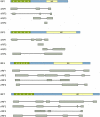The viral interferon regulatory factors of KSHV: immunosuppressors or oncogenes?
- PMID: 22566809
- PMCID: PMC3342017
- DOI: 10.3389/fimmu.2011.00019
The viral interferon regulatory factors of KSHV: immunosuppressors or oncogenes?
Abstract
Kaposi's sarcoma-associated herpesvirus (KSHV) is a large double-stranded DNA gammaherpesvirus, and the etiological agent for three human malignancies: Kaposi's sarcoma, primary effusion lymphoma, and multicentric Castleman's disease. To establish and maintain infection, KSHV has evolved unique mechanisms to evade the host immune response. Cellular interferon regulatory factors (IRFs) are a critical part of the host anti-viral immune response. KSHV encodes four homologs of IRFs, vIRF1-4, which inhibit the activity of their cellular counterparts. vIRF1, 2, and 3 have been shown to interact directly with cellular IRFs. Additionally, the vIRFs have other functions such as modulation of Myc, p53, Notch, transforming growth factor-β, and NF-κB signaling. These activities of vIRFs may contribute to KSHV tumorigenesis. KSHV vIRF1 and vIRF3 have been implicated as oncogenes, making the understanding of KSHV vIRF function vital to understanding KSHV pathogenesis.
Keywords: HHV-8; KSHV; vIRF.
Figures



Similar articles
-
Kaposi's Sarcoma-Associated Herpesvirus Viral Interferon Regulatory Factor 1 Interacts with a Member of the Interferon-Stimulated Gene 15 Pathway.J Virol. 2015 Nov;89(22):11572-83. doi: 10.1128/JVI.01482-15. Epub 2015 Sep 9. J Virol. 2015. PMID: 26355087 Free PMC article.
-
Genome-Wide Mapping of the Binding Sites and Structural Analysis of Kaposi's Sarcoma-Associated Herpesvirus Viral Interferon Regulatory Factor 2 Reveal that It Is a DNA-Binding Transcription Factor.J Virol. 2015 Nov 4;90(3):1158-68. doi: 10.1128/JVI.01392-15. Print 2016 Feb 1. J Virol. 2015. PMID: 26537687 Free PMC article.
-
Kaposi's sarcoma-associated herpesvirus viral interferon regulatory factor 4 (vIRF4) targets expression of cellular IRF4 and the Myc gene to facilitate lytic replication.J Virol. 2014 Feb;88(4):2183-94. doi: 10.1128/JVI.02106-13. Epub 2013 Dec 11. J Virol. 2014. PMID: 24335298 Free PMC article.
-
Pathological Features of Kaposi's Sarcoma-Associated Herpesvirus Infection.Adv Exp Med Biol. 2018;1045:357-376. doi: 10.1007/978-981-10-7230-7_16. Adv Exp Med Biol. 2018. PMID: 29896675 Review.
-
Kaposi's sarcoma-associated herpesvirus (KSHV)/human herpesvirus 8 (HHV-8) as a tumour virus.Herpes. 2003 Dec;10(3):72-7. Herpes. 2003. PMID: 14759339 Review.
Cited by
-
Role of Virally Encoded Circular RNAs in the Pathogenicity of Human Oncogenic Viruses.Front Microbiol. 2021 Apr 20;12:657036. doi: 10.3389/fmicb.2021.657036. eCollection 2021. Front Microbiol. 2021. PMID: 33959113 Free PMC article. Review.
-
Quantitative Analysis of the KSHV Transcriptome Following Primary Infection of Blood and Lymphatic Endothelial Cells.Pathogens. 2017 Mar 19;6(1):11. doi: 10.3390/pathogens6010011. Pathogens. 2017. PMID: 28335496 Free PMC article.
-
AKTivation of PI3K/AKT/mTOR signaling pathway by KSHV.Front Immunol. 2013 Jan 7;3:401. doi: 10.3389/fimmu.2012.00401. eCollection 2012. Front Immunol. 2013. PMID: 23316192 Free PMC article.
-
Molecular mechanisms of viral oncogenesis in humans.Nat Rev Microbiol. 2018 Nov;16(11):684-698. doi: 10.1038/s41579-018-0064-6. Nat Rev Microbiol. 2018. PMID: 30143749 Free PMC article. Review.
-
Role of Pattern Recognition Receptors in KSHV Infection.Cancers (Basel). 2018 Mar 20;10(3):85. doi: 10.3390/cancers10030085. Cancers (Basel). 2018. PMID: 29558453 Free PMC article. Review.
References
-
- Alexander L., Denekamp L., Knapp A., Auerbach M. R., Damania B., Desrosiers R. C. (2000). The primary sequence of rhesus monkey rhadinovirus isolate 26–95: sequence similarities to Kaposi’s sarcoma-associated herpesvirus and rhesus monkey rhadinovirus isolate 17577. J. Virol. 74, 3388–339810.1128/JVI.74.7.3388-3398.2000 - DOI - PMC - PubMed
-
- Alsharifi M., Mullbacher A., Regner M. (2008). Interferon type I responses in primary and secondary infections. Immunol. Cell Biol. 86, 239–245 - PubMed
-
- Angell J. E., Lindner D. J., Shapiro P. S., Hofmann E. R., Kalvakolanu D. V. (2000). Identification of GRIM-19, a novel cell death-regulatory gene induced by the interferon-beta and retinoic acid combination, using a genetic approach. J. Biol. Chem. 275, 33416–33426 - PubMed
Grants and funding
LinkOut - more resources
Full Text Sources
Research Materials
Miscellaneous

